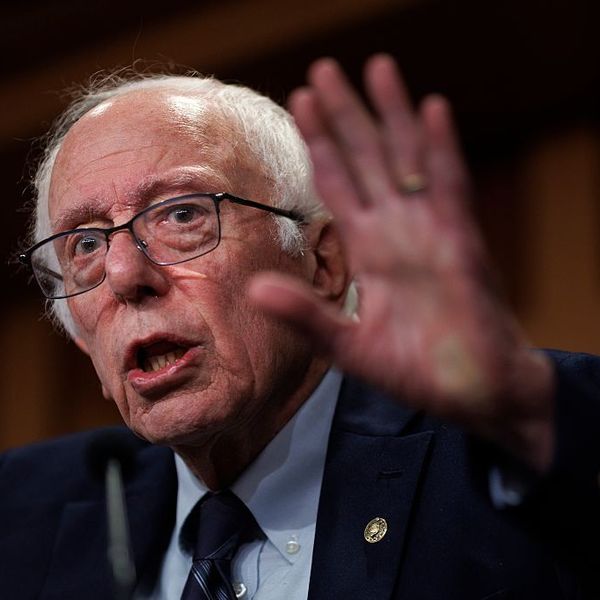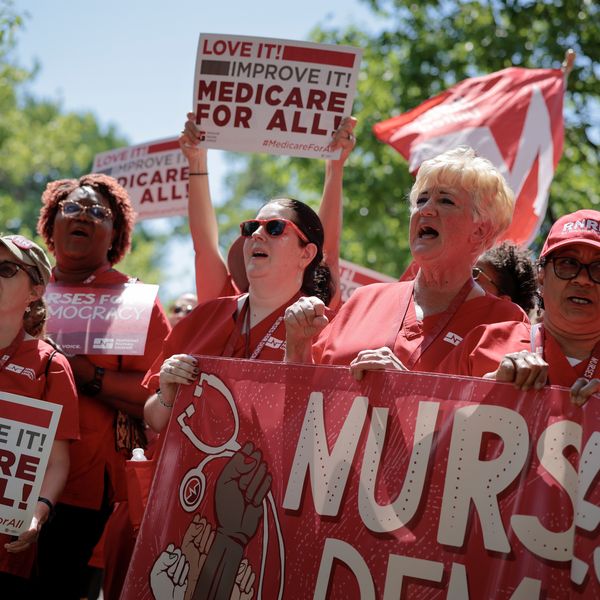The Urban Institute and the Tax Policy Center today released analyses of the costs of Sen. Bernie Sanders' domestic policy proposals, including single-payer national health insurance. They claim that Sanders' proposals would raise the federal deficit by $18 trillion over the next decade.
We won't address all of the issues covered in these analyses, just single-payer Medicare for all. To put it bluntly, the estimates (which were prepared by John Holahan and colleagues) are ridiculous. They project outlandish increases in the utilization of medical care, ignore vast savings under single-payer reform, and ignore the extensive and well-documented experience with single-payer systems in other nations - which all spend far less per person on health care than we do.
The authors' anti-single-payer bias is also evident from their incredible claims that physicians' incomes would be squeezed (which contradicts their own estimates positing a sharp rise in spending on physician services), and that patients would suffer huge disruptions, despite the fact that the implementation of single-payer systems elsewhere, as well as the start-up of Medicare, were disruption-free.
We outline below some of the most glaring errors in the Holahan analysis (which served as the basis for Tax Policy Center's estimates) regarding health care spending under the Sanders plan.
1. Administrative savings, Part 1: Holahan assumes that insurance overhead would be reduced to 6 percent of total health spending from the current level of 9.5 percent. They base this 6 percent estimate on figures for Medicare's current overhead, which include the extraordinarily high overhead costs of private Medicare HMOs run by UnitedHealthcare and other insurance firms. However, Sen. Sanders' proposal would exclude these for-profit insurers, and instead build on the traditional Medicare program, whose overhead is less than 3 percent. Moreover, even this 3 percent figure is probably too high, since Sanders' plan would simplify hospital payment by funding them through global budgets (similar to the way fire departments are paid), rather than the current patient-by-patient payments. Hence a more realistic estimate would assume that insurance overhead would drop to Canada's level of about 1.8 percent. Cutting insurance overhead to 2 percent (rather than the 6 percent that Holahan projects) would save an additional $1.7 trillion over the next 10 years.
2. Administrative savings, Part 2: Holahan completely ignores the huge savings on hospital administration and doctors' billing under a streamlined single-payer system. Every serious analyst of single-payer reform has acknowledged these savings, including the Congressional Budget Office, the Government Accountability Office, the Lewin Group (a consulting firm owned by UnitedHealth Group), and even Kenneth Thorpe (a former Clinton administration official who has criticized Sanders' plan, although his recent estimates of savings are far lower than those he made prior to the current presidential campaign).
These provider savings on paperwork would, in fact, be much larger than the savings on insurance overhead. At present, U.S. hospitals spend one-quarter of their total budgets on billing and administration, more than twice as much as hospitals spend in single-payer systems like Canada's or Scotland's. Similarly, U.S. physicians, who must bill hundreds of different insurance plans with varying payment and coverage rules, spend two to three times as much as our Canadian colleagues on billing.
Overall, these administrative savings for doctors and hospitals would amount to about $2.57 trillion over 10 years. Additional savings of more than $1.5 trillion from streamlined billing and administration would accrue to nursing homes, home care agencies, ambulance companies, drug stores and other health care providers.
In total, the Holahan analysis underestimates administrative savings by about $6 trillion over 10 years.
3. Drug costs: Holahan projects that a single-payer plan would have to pay 50 percent higher drug costs than those paid at present by Medicaid. Moreover, their estimate assumes that the U.S. would continue to pay much higher prices for drugs than other nations, despite the fact that a U.S. single-payer system would have much greater negotiating leverage with drug companies than other national health insurance schemes.
Reducing drug prices to the levels currently paid by European nations would save at least $1.1 trillion more than Holahan posits over 10 years.
4. Utilization of care: Holahan projects a massive increase in acute care utilization, but does not provide detailed breakdowns of how big an increase they foresee for specific services like doctor visits or hospital care. However, it is clear that the medical care system does not have the capacity to provide the huge surge in care that he posits.
For instance Holahan's figures for the increase in acute care suggest that Sanders' plan would result in more than 100 million additional doctor visits and several million more hospitalizations each year. But there just aren't enough doctors and hospital beds to deliver that much care. Doctors are already working 53 hours per week, and experience from past reforms tells us that they won't increase their hours, nor will they see many more patients per hour.
Instead of a huge surge in utilization, more realistic projections would assume that doctors and hospitals would reduce the amount of unnecessary care they're now delivering in order to deliver needed care to those who are currently not getting what they need. That's what happened in Canada. Doctors and hospitals can adjust care to meet increasing demand, as happens every year during flu season.
Moreover, no surge materialized when Medicare was implemented and millions of previously uninsured seniors got coverage. Between 1964 (before Medicare) and 1966 (the year when Medicare was fully functioning) there was absolutely no increase in the total number of doctor visit in the U.S.; Americans averaged 4.3 visits per person in 1964 and 4.3 visits per person in 1966. Instead, the number of visits by poor seniors went up, while the number of visits by healthy and wealthy patients went down slightly. The same thing happened in hospitals. There were no waiting lists, just a reduction in the utilization of unneeded elective care by wealthier patients, and the delivery of more care to sick people who needed it.
Bizarrely, despite projecting a roughly $1.6 trillion increase in total payments to doctors over 10 years, Holahan says in his discussion that "Physician incomes would be squeezed by the new payment rates."
5. Holahan's argument that the Sanders plan would cause a huge disruption of health care: This argument mirrors scare tactics used by Medicare's opponents in 1963. Back then, there were claims that doctors would boycott Medicare, and Wall Street Journal headlines warned of a "Patient Pileup," as "flocks of Medicare beneficiaries ... suddenly clog the nation's 7,200 hospitals." Nothing like that ever happened, nor did it happen when Taiwan implemented single payer more recently. And there's no reason to think it would happen here.
Moreover, surveys show that most doctors would welcome national health insurance, and thousands of doctors have recently issued a call (and detailed proposal) for single-payer reform in the American Journal of Public Health
In summary, Holahan grossly underestimates the administrative savings under single payer; projects increases in the number of doctor visits and hospitalizations that far exceed the capacity of doctors and hospitals to provide this added care; and posits that our country would continue to pay much more for drugs and medical equipment than people in every other nation with national health insurance.
Rather than increasing national health spending, as Holahan claims, Sanders' plan (and the plan proposed by Physicians for a National Health Program) would almost certainly decrease total health spending over the next 10 years.


